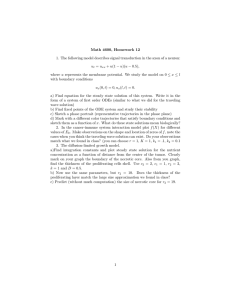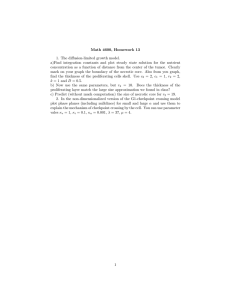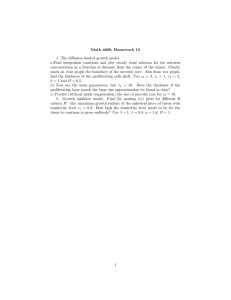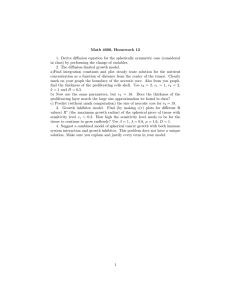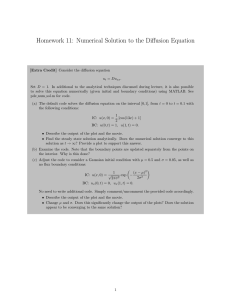Math 4600: Homework 12 Solutions Gregory Handy
advertisement
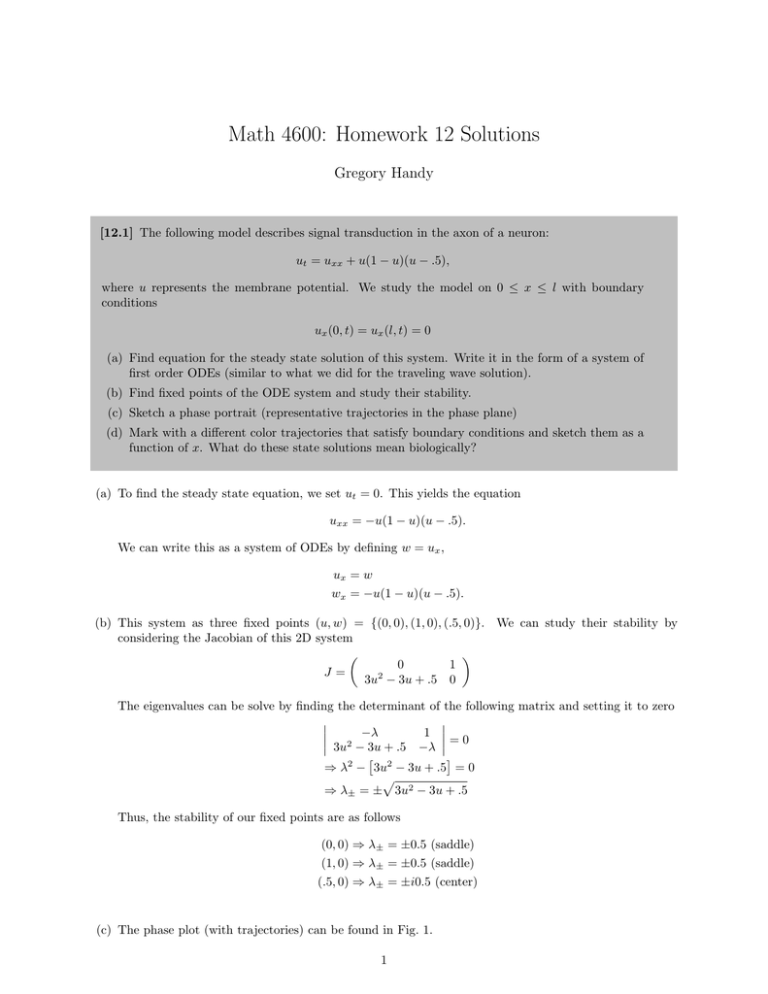
Math 4600: Homework 12 Solutions
Gregory Handy
[12.1] The following model describes signal transduction in the axon of a neuron:
ut = uxx + u(1 − u)(u − .5),
where u represents the membrane potential. We study the model on 0 ≤ x ≤ l with boundary
conditions
ux (0, t) = ux (l, t) = 0
(a) Find equation for the steady state solution of this system. Write it in the form of a system of
first order ODEs (similar to what we did for the traveling wave solution).
(b) Find fixed points of the ODE system and study their stability.
(c) Sketch a phase portrait (representative trajectories in the phase plane)
(d) Mark with a different color trajectories that satisfy boundary conditions and sketch them as a
function of x. What do these state solutions mean biologically?
(a) To find the steady state equation, we set ut = 0. This yields the equation
uxx = −u(1 − u)(u − .5).
We can write this as a system of ODEs by defining w = ux ,
ux = w
wx = −u(1 − u)(u − .5).
(b) This system as three fixed points (u, w) = {(0, 0), (1, 0), (.5, 0)}. We can study their stability by
considering the Jacobian of this 2D system
0
1
J=
3u2 − 3u + .5 0
The eigenvalues can be solve by finding the determinant of the following matrix and setting it to zero
−λ
1 3u2 − 3u + .5 −λ = 0
⇒ λ2 − 3u2 − 3u + .5 = 0
p
⇒ λ± = ± 3u2 − 3u + .5
Thus, the stability of our fixed points are as follows
(0, 0) ⇒ λ± = ±0.5 (saddle)
(1, 0) ⇒ λ± = ±0.5 (saddle)
(.5, 0) ⇒ λ± = ±i0.5 (center)
(c) The phase plot (with trajectories) can be found in Fig. 1.
1
Phase Plot
ux
0.5
0
−0.5
−0.5
0
0.5
u
1
1.5
Figure 1: Phase plane with trajectories. The trajectories start at the red dots and end at the magenta dots.
Orange line is the u-nullcline and the green lines are the ux -nullclines. The blue line matches the boundary
conditions.
(d) We need a trajectory that beings on the u-axis (since ux (0) = 0) and ends on the u-axis (since ux (l) = 0).
Of course, the fix point solutions u(x) = 0, u(x) = .5, and u(x) = 1 satisfy these conditions and represent
an axon that is constant for all x. A slightly more interesting solution can be seen in Fig. 2: it starts
low and ends high (the reverse is also a solution!). You could also think of a solution that oscillates a
couple of times before reaching l (if l is large enough), as long as ux (0) = ux (l) = 0.
Steady State Solution
1
0.8
u(x)
0.6
0.4
0.2
0
0
2
4
6
8
10
x
Figure 2: Example trajectory that satisfies the boundary condition (choosing l = 10).
[12.2] In the cancer-immune system interaction model plot f (X) for different values of E0 . Make
observations on the shape and location of zeros of f, note the cases when you think the traveling
wave solution can exist. Do your observations match what we found in class? (you can choose r = 1,
K = 1, k1 = .1, k2 = 0.1).
From class, we know the full equation is
∂X
X
k2 k1 E0 X
= rX 1 −
−
+ D∇2 X.
∂τ
K
k2 + k1 X
It follows that
X
f (X) = rX 1 −
K
2
−
k2 k1 E0 X
.
k2 + k1 X
With the given parameter values, we can plot this function with different values of E0 . When E0 = 0.1 and
E0 = 5, we see that f (X) has one root greater than zero, but when E0 = 15, this root is lost. This follows
the result from class: when r > k1 E0 , we expect a single positive root, whereas when r < k1 E0 , f (X) < 0
for all positive X. For our parameters values, we have 1 > 0.1E0 , and so the threshold of losing the positive
root is E0 = 10.
E0 = 0.10
E0 = 5.00
E0 = 15.00
0.5
0.5
0.5
0
0
0
−0.5
−0.5
−0.5
−1
−0.5
0
0.5
1
1.5
−1
−0.5
2
0
0.5
1
1.5
2
−1
−0.5
0
0.5
1
1.5
2
Figure 3: Plot of f (X) for different values of E0 .
[12.3] The diffusion-limited growth model.
(a) Find integration constants and plot steady state solution for the nutrient concentration as a
function of distance from the center of the tumor. Clearly mark on your graph the boundary
of the necrotic core. Also from you graph, find the thickness of the proliferating cells shell. Use
c2 = 2, c1 = 1, r2 = 2, k = 1 and D = 0.5.
(b) Now use the same parameters, but r2 = 10. Does the thickness of the proliferating layer match
the large size approximation we found in class?
(c) Predict (without much computation) the size of necrotic core for r2 = 19.
(a) Note that with these parameters
r22 = 4 and 6(c2 − c1 )
D
D
= 3 ⇒ r22 > 6(c2 − c1 ) ,
k
k
meaning our tumor is above the critical radius, and we expect r1 > 0 (the radius of the necrotic core).
It follows that we seek to solve the following ODE
D d
2 dc
r
, for r1 < r < r2
0 = −k + 2
r dr
dr
subject to the boundary conditions
c(r1 ) = c1 ,
dc
(r1 ) = 0, c(r2 ) = c2 .
dr
Multiplying through our ODE by r2 and integrating yields
k
dc
k
dc
A
A = − r3 + Dr2
⇒ 0 = − r + D + 2.
3
dr
3
dr r
3
After integrating again, we find
k
A
0 = − r2 + Dc(r) + + B
6
r
1k 2 A
⇒ c(r) =
r + + B,
6D
r
where A and B are integrating constants. Using the boundary conditions, we find the following set of
equations
c1 =
1k 2 A
1k 2 A
1k
A
r1 +
+ B, c2 =
r2 +
+ B, 0 =
r1 − 2 .
6D
r1
6D
r2
3D
r1
So we have three equations and three unknowns, meaning we can solve for our integrating constants A,
and B, as well as the radius r1 . After a little manipulation, we find the following
r1
1k
1+2
(r2 − r1 )2 .
c2 − c1 =
6D
r2
This is a cubic equation for r1 , and thus, we can solve for r1 numerically. Assuming that we know r1
from this formula, we can then solve for A,
0=
A
1k 3
1k
r1 − 2 ⇒ A =
r .
3D
r1
3D 1
Using this, we can also solve for B
c1 =
1 k 3
r
1k 2 A
1k 2
r1 +
r1 + 3 D 1 + B
+ B ⇒ c1 =
6D
r1
6D
r1
1k 2
r .
⇒ B = c1 −
2D 1
Using the parameters for the problem, we find r1 = 0.6527, A = 0.1854, and B = 0.5740. The thickness
of the proliferating cells shell is r2 − r1 = 1.3473.
3
2.5
c(r)
2
1.5
1
0.5
0
0
0.5
1
1.5
r
2
2.5
3
Figure 4: Plot of the nutrient concentration with r2 = 2. The dotted line denotes the boundary of the
necrotic core.
(b) Taking r2 = 10, but using the same parameters otherwise, we find r1 = 8.9636, A = 480.1190, and
B = −79.3452. It follows that the thickness of the proliferating cells shell is r2 − r1 = 1.0364. From
class, the thickness can be approximated by (in the large cell limit)
h2 = 2
D
(c2 − c1 ) ⇒ h = 1,
k
which is close to our numerical answer.
4
3
2.5
c(r)
2
1.5
1
0.5
0
0
2
4
6
8
10
r
Figure 5: Plot of the nutrient concentration with r2 = 10. The dotted line denotes the boundary of the
necrotic core.
(c) Since the thickness approximated in the large cell limit was close for r2 = 10, this approximation can be
used directly for r2 = 19. Thus, we know h = 1, meaning the thickness of the necrotic core is r1 ≈ 18.
%%%%%%%%%%%%%%%%%%%%%%%%%%%%%%%%%%%%%%%%%%%%%%%%
clc;
clear;
close all;
c_2 = 2;
c_1=1;
r_2=2;
k=1;
D=0.5;
%% Esimate r_1 numerically
r_1 = -2:0.00001:40;
f = c_2-c_1-1/6*k/D*(1+2*r_1/r_2).*(r_2-r_1).^2;
temp = find(abs(f)<10^-5);
for i = 1:length(temp)
if r_1(temp(i)) > 0 && r_1(temp(i)) < r_2
current_value = r_1(temp(i));
end
end
%% Plot c(r)
r_1=current_value
A = 1/3*k/D*r_1^3
B = c_1-1/2*k/D*r_1^2
r=[0:.01:r_2];
c = zeros(length(r),1);
for i = 1:length(r)
5
for i = 1:length(r)
if r(i) < r_1
c(i) = c_1;
elseif r(i) > r_1 && r(i) < r_2
c(i) = 1/6*k/D*r(i)^2+A/r(i)+B;
else
c(i) = c_2;
end
end
y = [0:.01:3];
figure;
plot(ones(length(y),1)*r_1,y,’--’,’color’,’black’,’linewidth’,1.5)
hold on
plot(r,c,’blue’,’linewidth’,1.5)
axis([0 r_2 0 3])
set(gca,’fontsize’,16)
xlabel(’r’,’fontsize’,16)
ylabel(’c(r)’,’fontsize’,16)
6
